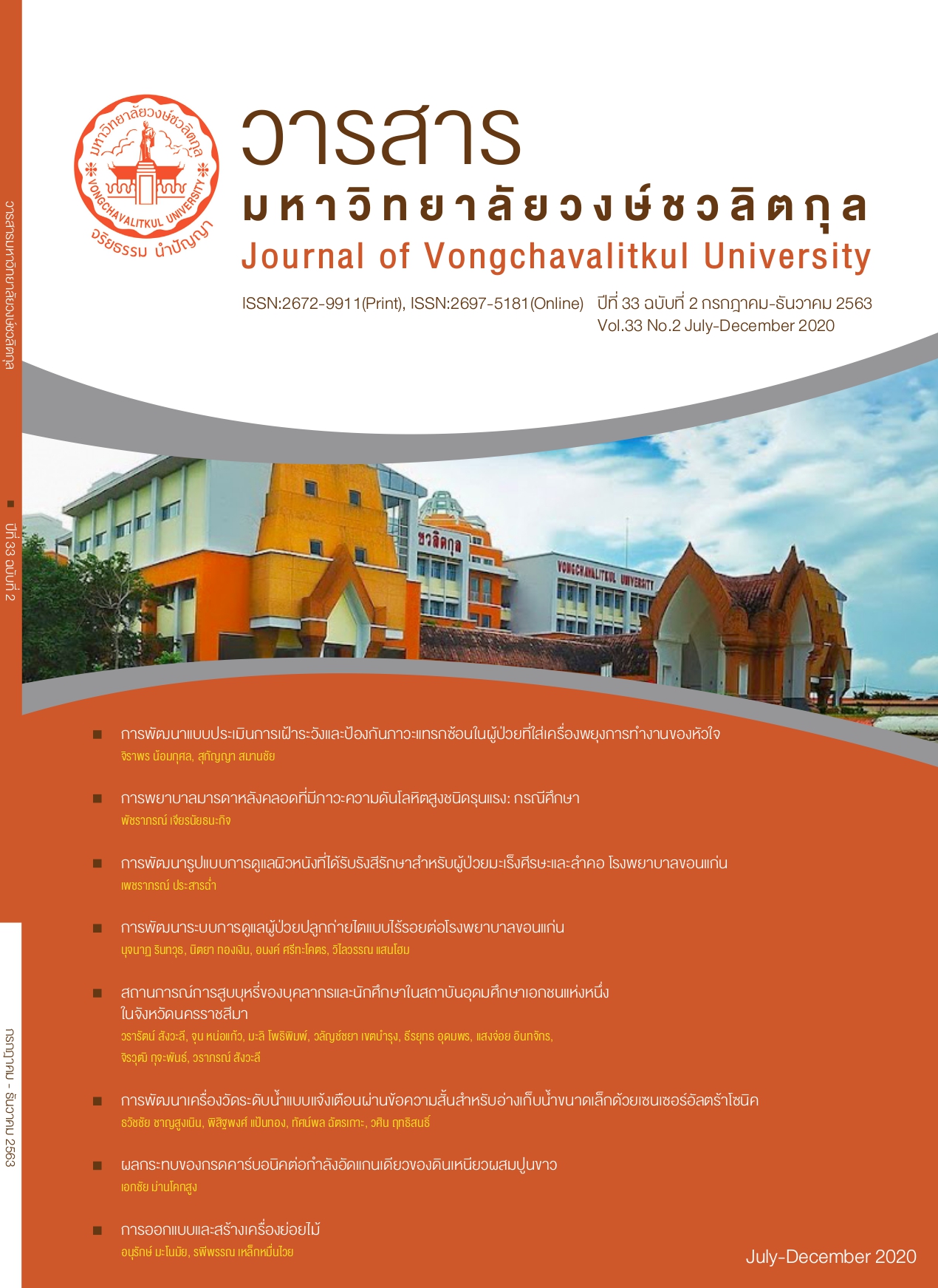Development of Radiotherapy-Treated Skin Care Model for Patients with Head and Neck Cancer, Khon Kaen Hospital
Main Article Content
Abstract
Objective: This action research aimed to develop a radiotherapy-treated skin care model for patients with head and neck cancer.
Methods: Purposive sampling was used to recruit fourteen patients with head and neck cancer receiving radiotherapy-treated in Khon Kaen Hospital. This research used the Ottawa Charter Health Promotion concept and the Chronic Care Model concept to develop the care model. Data collection instruments were questionnaires and the radiotherapy skin change assessment form of Radiotherapy Oncology Group (RTOG) used in Khon Kaen Hospital.
Results: Situation analysis revealed the insufficient support of knowledge and skill on skin care for the patients. Results of the development of radiotherapy-treated skin care model consisted of eight parts: (1) evaluate and educate patient and relative, (2) supervise patient and relative to assess the patient skin every morning, (3) patient, relative and nurse jointly plan for the skin care, (4) inform patient to wear soft, wide-necked clothes, (5) use normal saline solution (NSS) for wound dressing of the affected area, (6) avoid an applying the plaster directly over the line of the skin, (7) strictly use the skin medication according to the individual treatment plan, and (8) advise the patient for the care methods of the exposed skin, contraindications and recommended procedures, and emphasizing on cleaning the body and bathing with mild soap.
Results of implementing the care model on patients with head and neck cancer who received radiotherapy found that the rate of grade 3-4 skin reaction was decreased from 0.43% to 0.29%, the patient and nurse satisfaction at high level were at 98% and 100% respectively. The care model for head and neck cancer is expected to be expanded to other hospitals in order to provide better quality patient care.
Article Details
References
2. นุชรัตน์ มังคละคีรี และคณะ. (2556) รูปแบบการสร้างเสริมสุขภาพโดยชุมชนมีส่วนร่วม กรณีศึกษาพนักงานตีเหล็ก กลุ่มตีเหล็กตำบลนาถ่อน อำเภอธาตุพนม จังหวัดนครพนม. วารสารมหาวิทยาลัยทักษิณ, 16(2), 67-72.
3. พวงทอง ไกรพิบูลย์ และคณะ. (2554). ตำรารังสีรักษา: ฟิสิกส์ชีวรังสี การพยาบาลผู้ป่วย (พิมพ์ครั้งที่ 1). กรุงเทพฯ: ไทยวัฒนาพานิช.
4. มนทกานติ์ บุตรคำ และบำเพ็ญจิต แสงชาติ. (2559). ผลของการดูแลผิวหนังบริเวณที่ได้รับรังสีรักษาด้วยวิธีที่แตกต่างกันต่อการเปลี่ยนแปลงของผิวหนังในผู้ป่วยมะเร็งศีรษะและลำคอ (พิมพ์ครั้งที่ 1). ขอนแก่น: มหาวิทยาลัยขอนแก่น.
5. โรงพยาบาลขอนแก่น. (2558). รายงานทะเบียนมะเร็งประจำปี 2557 โรงพยาบาลขอนแก่น (พิมพ์ครั้งที่ 1). ขอนแก่น: ขอนแก่นการพิมพ์.
6. ศุภาวดี พันธ์หนองโพน. (2562). การพัฒนารูปแบบการดูแลผู้ป่วยโรคเบาหวานชนิดที่ 2 ภายใต้รูปแบบการ จัดการโรคเรื้อรัง (Chronic Care Model) ในคลินิกโรคเบาหวาน โรงพยาบาลขุนหาญ อ.ขุนหาญ จ.ศรีสะเกษ. สาธารณสุขศาสตรมหาบัณฑิต, มหาวิทยาลัยมหาสารคาม, มหาสารคาม.
7. สถาบันมะเร็งแห่งชาติ. (2561). ทะเบียนมะเร็งระดับโรงพยาบาลปี 2560: Hospital based cancer registry 2017 (พิมพ์ครั้งที่ 1). กรุงเทพฯ: โฆสิตการพิมพ์ จำกัด.
8. สินศักดิ์ชนม์ อุ่นพรมมี. (2556). พัฒนาการสำคัญของการสร้างเสริมสุขภาพ รายงานการประชุมระดับโลก เรื่องการสร้างเสริมสุขภาพ. โครงการสวัสดิการวิชาการสถาบันพระบรมราชชนก. กรุงเทพฯ:
ธนเพลส จำกัด. 1-8.
9. สมาคมส่งเสริมความรอบรู้ด้านสุขภาพไทย. (2562). กฎบัตรอ๊อตตาวาเพื่อการส่งเสริมสุขภาพ (Ottawa Charter for Health Promotion -1986). สืบค้น 2 ตุลาคม 2562, จาก http://122.154. 73.26/hl/index.php?module=!&file=InterestingTopic2.php&cat=a00
10. อังกาบ แสนยันต์. (2558). เอกสารประกอบการสอน: เรื่อง Nursing Management of the client receiving Radiation Therapy (พิมพ์ครั้งที่ 1). กรุงเทพฯ.
11. อรวรรณ สัมภวมานะ, ลินดา คล้ายปักษี, พนิดา อาวุธ, และโศรตรีย์ แพน้อย. (2560). การพัฒนาการจัดการระบบการดูแลผู้ป่วยโรคเรื้อรังของโรงพยาบาลส่งเสริมสุขภาพตำบล: กรณีศึกษา โรงพยาบาลส่งเสริมสุขภาพ ตำบลมะลวน อ.พุนพิน จ.สุราษฎร์ธานี. วารสารพยาบาลกระทรวงสาธารณสุข, 27(1), 157-167.
12. Deming. (1950). ความเป็นเลิศของ Deming. [Online available] สืบค้น 12 กันยายน 2562, จาก http://adisony. blogspot.com/2012/10/edward-deming.html
13. Feight, D., Baney, T., Bruce, S. & McQuestion, M. (2011). Putting evidence into practice: Evidence-based interventions for radiation dermatitis. Clinical Journal of Oncology Nursing, 15(5), 481-492.
14. Iwamoto, Ryan R., Haas, Marilyn L., & Gosselin, Tracy K. (2012). Manual for radiation oncology nursing practice and education (4thed.). U.S.A.
15. Rong - Xi L. et al. (1989). Comparison of continuous and spilt course Radiotherapy for nasopharyngeal carcinoma. The National Journal of Radiation Oncology Biology Physics, 16, 307-10.
16. Srinagarin Hospital, Khon Kaen University. (2557). Hospital-Based Cancer Registry 2017 (พิมพ์ครั้งที่ 1). ขอนแก่น: มหาวิทยาลัยขอนแก่น.
17. United States Cancer Statistics. (2017). Data Visualizations. สืบค้น 2 ตุลาคม 2562, จาก https://gis.cdc. gov/Cancer/USCS/DataViz.html
18. Wagner, E. H., Austin, B. T., Davis, C., Hindmarsh, M., Schaefer, J. & Bonomi, A. (2001). Improving chronic illness care: translating evidence into action. Health Affairs, 20(6), 64-78.


